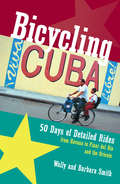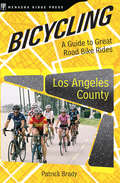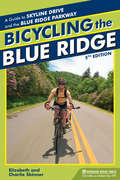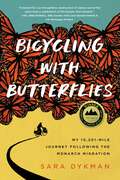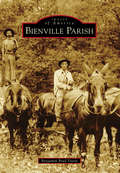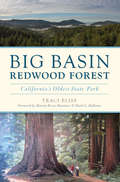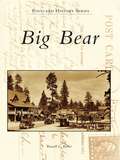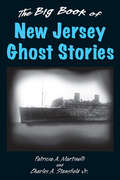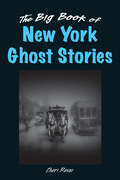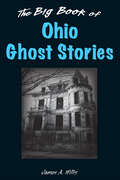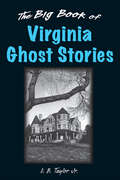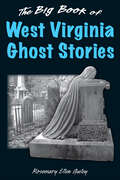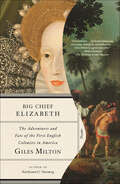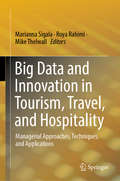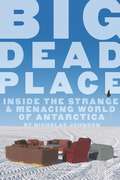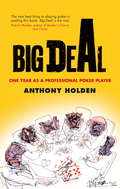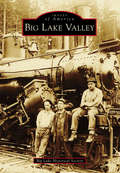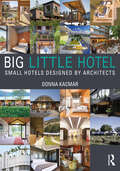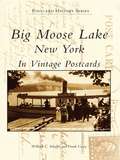- Table View
- List View
Bicycle Diaries
by David ByrneA renowned musician and visual artist presents an idiosyncratic behind-the-handlebars view of the world’s cities Since the early 1980s, David Byrne has been riding a bike as his principal means of transportation in New York City. Two decades ago, he discovered folding bikes and started taking them on tour. Byrne’s choice was made out of convenience rather than political motivation, but the more cities he saw from his bicycle, the more he became hooked on this mode of transport and the sense of liberation it provided. Convinced that urban biking opens one’s eyes to the inner workings and rhythms of a city’s geography and population, Byrne began keeping a journal of his observations and insights. An account of what he sees and whom he meets as he pedals through metropoles from Berlin to Buenos Aires, Istanbul to San Francisco, Manila to New York, Bicycle Diaries also records Byrne’s thoughts on world music, urban planning, fashion, architecture, cultural dislocation, and much more, all conveyed with a highly personal mixture of humor, curiosity, and humility. Part travelogue, part journal, part photo album, Bicycle Diaries is an eye-opening celebration of seeing the world from the seat of a bike. .
Bicycling Cuba: 50 Days of Detailed Rides from Havana to El Oriente
by Barbara Smith Wally SmithDiscover all Cuba has to offer in this complete cycling guide. Wally and Barbara Smith spent 6 months cycling 8,000 miles in Cuba to provide detailed directions for 50 days of cycling. The rides vary in length, many combining to create multi-day loops. Detailed directions describe rides leaving Havana to the west and east. Subsequent rides are clustered in the three best regions of Cuba for cycling: Pinar del Rio, Central Cuba, and the Oriente. A final section contains advice on connecting the regions for a long tour of the entire island. In addition, the authors provide information on getting to Cuba, equipment and accessories, food and water, safety considerations, overnight accommodations, and more. Exploring this fascinating country on two wheels may just be the best way to fully appreciate its history, people, and culture.
Bicycling Los Angeles County
by Patrick BradyThe geography of Southern California is as infinitely varied as its population. From the serenity of coastal beaches to the majestic San Gabriel Mountains and the tight canyons of the Santa Monica Mountains, Los Angeles is a cyclist's paradise. The vistas are spectacular, the terrain fun to ride and the sights include some of Hollywood's best-known landmarks.Bicycling Los Angeles County takes riders on 40 different rides throughout Southern California's most popular destination. Also detailed for avid roadies are some of Los Angeles' most popular group rides - for those who want a more challenging and social outing.
Bicycling the Blue Ridge
by Charlie Skinner Elizabeth SkinnerThere is no ribbon of highway more ideal for cycling than the Skyline Drive and Blue Ridge Parkway - they both entice the senses and physically challenge the body. The new edition of Bicycling the Blue Ridge continues as the definitive guide to this cyclist's dream road, offering completely updated information on lodging, bike shops, campgrounds, road crossings, points of interest, bed and breakfasts, panoramic views, groceries, and more. Written with racers, touring cyclists, and recreational cyclists in mind, this milepost-by-milepost guide covers every inch of the 574-mile path between Front Royal, Virginia, and Cherokee, North Carolina.
Bicycling with Butterflies: My 10,201-Mile Journey Following the Monarch Migration
by Sara Dykman&“What a wonderful idea for an adventure! Absolutely inspired, timely, and important.&” —Alistair Humphreys, National Geographic Adventurer of the Year and author of The Doorstep Mile and Around the World by Bike Outdoor educator and field researcher Sara Dykman made history when she became the first person to bicycle alongside monarch butterflies on their storied annual migration—a round-trip adventure that included three countries and more than 10,000 miles. Equally remarkable, she did it solo, on a bike cobbled together from used parts. Her panniers were recycled buckets. In Bicycling with Butterflies, Dykman recounts her incredible journey and the dramatic ups and downs of the nearly nine-month odyssey. We&’re beside her as she navigates unmapped roads in foreign countries, checks roadside milkweed for monarch eggs, and shares her passion with eager schoolchildren, skeptical bar patrons, and unimpressed border officials. We also meet some of the ardent monarch stewards who supported her efforts, from citizen scientists and researchers to farmers and high-rise city dwellers. With both humor and humility, Dykman offers a compelling story, confirming the urgency of saving the threatened monarch migration—and the other threatened systems of nature that affect the survival of us all.
Bienville Parish (Images of America)
by Benjamin Brad DisonBienville Parish, founded in 1848, is located in central north Louisiana. While perhaps most well-known for its ties to outlaws Bonnie and Clyde, Bienville Parish has a rich timber and railroad history that has shaped the community for over a century. Settlers moved into the region to take advantage of its flourishing industry, but it was community that led people to put down roots in the area. Religion and education formed the basis of everyday life in the rural region. In this photographic history, Bienville Parish is depicted through the lives of the people who inhabited the area. Although its size has decreased in recent years, the people who still reside in the parish have made it a priority to preserve the memories for future generations.
Big Basin Redwood Forest: California's Oldest State Park (Landmarks)
by Traci BlissThe epic saga of Big Basin began in the late 1800s, when the surrounding communities saw their once "inexhaustible" redwood forests vanishing. Expanding railways demanded timber as they crisscrossed the nation, but the more redwoods that fell to the woodman's axe, the greater the effects on the local climate. California's groundbreaking environmental movement attracted individuals from every walk of life. From the adopted son of a robber baron to a bohemian woman winemaker to a Jesuit priest, resilient campaigners produced an unparalleled model of citizen action. Join author Traci Bliss as she reveals the untold story of a herculean effort to preserve the ancient redwoods for future generations.
Big Bear
by Russell L. Keller Stanley E. BellamyIn 1845, Benjamin Davis Wilson--the future first mayor of Los Angeles and the grandfather of Gen. George S. Patton--led a 20-man posse into the San Bernardino Mountains in search of Native American raiding parties that had been attacking Riverside ranches. But what they found in a particular high-altitude valley were, instead, large and furry. Wilson's men soon roped 11 bears, bringing the creatures into camp, and the valley the Serrano Indians knew as Yuhaviat, or "Pine Place," received a new map designation. Wilson named a nearby body of water Big Bear Lake (now Baldwin Lake, with the present-day, man-made lake co-opting the bruin moniker). Today, at elevations between 6,000 and 9,000 feet, the city of Big Bear Lake is an hour and a half from Los Angeles and a million miles from the rat race, where hiking, sports, and the absence of exertion thrive in a vacation atmosphere.
Big Bear (Postcard History Series)
by Russell L. KellerBig Bear is known throughout the southland of California as an outdoor recreational destination. Located high atop the San Bernardino Mountains, the area was once home to the Yuhaviatam Indians, the "People of the Pines." In 1845, a party lead by Benjamin Davis Wilson, the grandfather of Gen. George S. Patton, entered the valley and discovered the area alive with grizzly bears, giving the valley its name. A dam, completed in 1884, created Big Bear Lake, which provided water to citrus growers in the area of Redlands and later lead to the water-related recreations, camps, resorts, and the welcoming community that Big Bear is famous for today.
Big Book of New Jersey Ghost Stories (Big Book of Ghost Stories)
by Patricia Martinelli Charles A Stansfield Jr.&“An entertaining collection . . . set in the region&’s forests, villages, urban centers, and seaports. . . . an artful blend of fine writing and thorough research.&” —Ed Okonowicz, Author of Big Book of Maryland Ghost Stories and Civil War Ghosts at Ft Delaware Reader, beware! Turn these pages and enter the world of the paranormal, where ghosts and ghouls alike creep just out of sight. Authors Patricia A. Martinelli and Charles A. Stansfield Jr. shine a light in the dark corners of New Jersey and scare those spirits out of hiding in this thrilling collection. From what may lurk in the Ramapo Mountains, to a ghostly little boy who waits on Clinton Road, and the fabled Jersey Devil itself, these stories of strange occurrences will keep you glued to the edge of your seat. Around the campfire or tucked away on a dark and stormy night, this big book of ghost stories is a hauntingly good read. 184 of the best, most spine-tingling accounts of ghosts from the Garden State, including: · The pale phantom of Devil&’s Tower in Alpine · Colonial ghosts of Greenwich · The beachcombing Woman in White · Indian Will&’s wandering spirit in Eatontown · Woodstown&’s haunted Seven Stars Tavern · The helpful hospital ghost in Elizabeth
Big Book of New York Ghost Stories (Big Book of Ghost Stories)
by Cheri RevaiHauntings lurk and spirits linger in the Empire State—from Manhattan&’s Ear Inn to the Seneca Hill Ghost in Oswego. Reader, beware! Turn these pages and enter the world of the paranormal, where ghosts and ghouls alike creep just out of sight. Author Cheri Farnsworth shines a light in the dark corners of New York and scares those spirits out of hiding in this thrilling collection. From apparitions and objects that fly off of tables at the Manhattan Bistro, to a specter that stalks Pulpit Rock in Lake Placid, there&’s no shortage of bone-chilling tales to keep you up at night. Around the campfire or tucked away on a dark and stormy night, this big book of ghost stories is a hauntingly good read. &“Whether you&’re an armchair ghost enthusiast or prefer to visit haunted locales, this book, excellently organized for both, is a perfect guide and companion.&” —Tamara Thorne, author of Old Wives&’ Tales
Big Book of Ohio Ghost Stories (Big Book of Ghost Stories)
by James A Willis&“Chronicling the haunted history . . . of Ohio . . .&” a collection of &“chillingly entertaining ghostly tales [from] a master storyteller.&” (Mark Moran, Co-creator of the Weird U.S. book series) Reader, beware! Turn these pages and enter the world of the paranormal, where ghosts and ghouls alike creep just out of sight. Author James A. Willis shines a light in the dark corners of Ohio and scares those spirits out of hiding in this thrilling collection. From ghostly soldiers that still haunt Fort Meigs to the eerie Franklin Castle, there&’s no shortage of bone-chilling tales to keep you up at night. There&’s even a carved tombstone of an infant at Cedar Hill cemetery, whose ghostly eyes keep watch over those who wander too close. Around the campfire or tucked away on a dark and stormy night, this big book of ghost stories is a hauntingly good read. &“Sure to satisfy anyone&’s hankering for hauntings, havoc, and horror in the &‘boo-tiful&’ Buckeye State.&” —Linda S. Godfrey, Author of Haunted Wisconsin and Real Wolfmen
Big Book of Virginia Ghost Stories (Big Book of Ghost Stories)
by L. B Taylor&“Packs big entertainment, from famous ghosts and weird hauntings to bizarre but riveting true stories that will give you quite a chill.&” —Rosemary Ellen Guiley, author of The Encyclopedia of Ghosts and Spirits Hauntings lurk and spirits linger in the Old Dominion State . . . Reader, beware! Turn these pages and enter the world of the paranormal, where ghosts and ghouls alike creep just out of sight. Author L. B. Taylor shines a light in the dark corners of Virginia and scares those spirits out of hiding in this thrilling collection. From poltergeists that make trouble at Blue Ridge Pottery, to a phantom light on Holston Mountain, to specters haunting the battlefield of Cedar Creek, there&’s no shortage of bone-chilling tales to keep you up at night. Around the campfire or tucked away on a dark and stormy night, this big book of ghost stories is a hauntingly good read.
Big Book of West Virginia Ghost Stories (Big Book of Ghost Stories)
by Rosemary Ellen GuileyThis &“fantastic collection of the Mountain State's ghostlore . . . takes readers into the legends and the phenomena like no one else can&” (Jeff Belanger, author of The World&’s Most Haunted Places). Rich in history and natural splendor, West Virginia also boasts a wealth of unexplained mysteries. In this volume, noted paranormal researcher Rosemary Ellen Guiley delves into more than one hundred accounts of hauntings from across the state. From the restless spirits of the Hatfields and McCoys to John Brown&’s ghost at Harper&’s Ferry, Guiley shows that the region&’s history is still very much with us. She also explores lesser-known mysterious places such as Droop Mountain, where headless spectors roam, and the Trans-Allegheny Lunatic Asylum, a site replete with tortured phantoms. Around the campfire or tucked away on a dark and stormy night, this big book of ghost stories is a hauntingly good read.
Big Chief Elizabeth: The Adventures and Fate of the First English Colonists in America
by Giles MiltonIn April 1586, Queen Elizabeth I acquired a new and exotic title. A tribe of Native Americans had made her their weroanza—a word that meant "big chief". The news was received with great joy, both by the Queen and her favorite, Sir Walter Ralegh. His first American expedition had brought back a captive, Manteo, who caused a sensation in Elizabethan London. In 1587, Manteo was returned to his homeland as Lord and Governor, with more than one hundred English men, women, and children, to establish the settlement of Roanoke, Virginia. But in 1590, a supply ship arrived at the colony to discover that the settlers had vanished.For almost twenty years the fate of Ralegh's colonists was to remain a mystery. When a new wave of settlers sailed to America to found Jamestown, their efforts to locate the lost colony of Roanoke were frustrated by the mighty chieftain, Powhatan, father of Pocahontas, who vowed to drive the English out of America. Only when it was too late did the settlers discover the incredible news that Ralegh's colonists had survived in the forests for almost two decades before being slaughtered in cold blood by henchmen. While Manteo, Sir Walter Ralegh's "savage," had played a pivotal role in establishing the first English settlement in America, he had also unwittingly contributed to one of the earliest chapters in the decimation of the Native American population. The mystery of what happened to the Roanoke colonists, who seemed to vanish without a trace, lies at the heart of this well-researched work of narrative history.
Big Data and Innovation in Tourism, Travel, and Hospitality: Managerial Approaches, Techniques, and Applications
by Marianna Sigala Roya Rahimi Mike ThelwallThis book brings together multi-disciplinary research and practical evidence about the role and exploitation of big data in driving and supporting innovation in tourism. It also provides a consolidated framework and roadmap summarising the major issues that both researchers and practitioners have to address for effective big data innovation.The book proposes a process-based model to identify and implement big data innovation strategies in tourism. This process framework consists of four major parts: 1) inputs required for big data innovation; 2) processes required to implement big data innovation; 3) outcomes of big data innovation; and 4) contextual factors influencing big data exploitation and advances in big data exploitation for business innovation.
Big Dead Place
by Nicholas JohnsonJohnson's savagely funny [book] is a grunt's-eye view of fear and loathing, arrogance and insanity in a dysfunctional, dystopian closed community. It's like M*A*S*H on ice, a bleak, black comedy."--The Times of London
Big Deal: One Year as a Professional Poker Player
by Anthony HoldenBIG DEAL is the mesmerising story of a year spent by bestselling biographer Anthony Holden in the tough world of the professional poker player. He spent days and nights in the poker paradise of Las Vegas, in Malta and Morocco, even shipboard, mingling with the legendary greats, sharpening his game, perfecting his repartee, and learning a great deal about himself in the process.Poker, Holden would insist, is not gambling. Like chess it is a paradigm of life at its most intense, a gladiatorial contest that brings out the best as well as the worst in people. Its heroes, its eccentrics and is comedians stalk the pages of this remarkable book, along with all the hair-raising, nail-biting excitement of the games themselves.A classic of the genre, BIG DEAL is here reissued with a new introduction by the author.
Big Deal: One Year as a Professional Poker Player
by Anthony HoldenBIG DEAL is the mesmerising story of a year spent by bestselling biographer Anthony Holden in the tough world of the professional poker player. He spent days and nights in the poker paradise of Las Vegas, in Malta and Morocco, even shipboard, mingling with the legendary greats, sharpening his game, perfecting his repartee, and learning a great deal about himself in the process.Poker, Holden would insist, is not gambling. Like chess it is a paradigm of life at its most intense, a gladiatorial contest that brings out the best as well as the worst in people. Its heroes, its eccentrics and is comedians stalk the pages of this remarkable book, along with all the hair-raising, nail-biting excitement of the games themselves.A classic of the genre, BIG DEAL is here reissued with a new introduction by the author.
Big Game, Small World: A Basketball Adventure
by Alexander WolffAlex Wolff canvasses the globe and travels to 16 different countries (and 10 states in the U. S.) to find out exactly why basketball has become a worldwide phenomenon. Whether it's in a pick-up game on the Royal court in Bhutan, in the heart of a former female college player of the year turned cloistered nun, in the tragedy of the legendary junior national team in war torn Yugoslavia, or in the life's work of one of the greatest players to ever play in the NBA, Alex Wolff discovers that basketball can define an individual, a race, a culture, and in some instances even a country. Fusing John Feinstein's talent for finding the human drama behind sport with Bill Bryson's travelogue style, Wolff shows how the power and love of basketball extends to the four corners of the earth and engages people of all cultures, races, genders, and generations.
Big Lake Valley (Images of America)
by Big Lake Historical SocietyA beautiful lake surrounded by virgin timber was enough for Dr. Hyacinthe P. Montborne to homestead here in 1884. He set up a shingle mill at Montborne in 1887, at the same time Hugh Walker was setting up a shingle mill in Walker Valley. With the establishment of the Seattle, Lake Shore & Eastern Railroad along the shoreline of Big Lake, the valley began to boom. The Day Lumber Company at Big Lake and the Nelson Neal Lumber Company at Montborne each established lumber mills. Their operations were far-reaching into the vast timberlands. With families homesteading near and far, the Finn Settlement, Ehrlich, Big Lake, Big Rock, and Baker Heights joined Walker Valley and the town of Montborne as communities. The mills are now gone, but the communities in the Big Lake Valley have survived, and generations of families, both old and new, continue to call it home.
Big Little Hotel: Small Hotels Designed by Architects
by Donna KacmarThis book showcases small hotels, all located in the United States, designed by architects who use light and materials in interesting and intentional ways. The designs also deliberately connect to their local history, context, or land – in many cases all three. Both the architecture and the operations harmonize with the place, whether that is a bustling city, small town, or natural area. Many are new buildings but some are adaptive reuse projects or renovations of historic properties, extending the connectivity of the place into the future. A condensed history of lodging helps to place the many typologies and histories of hospitality in relationship to world events and includes the many factors that influence hotel development such as business practices, technology, and even politics. Hotels are influenced by larger trends and innovations in hospitality such as the emergence of a variety of creative possibilities for future travel. A final chapter includes speculation on travel trends and encourages us all to wander more intentionally.
Big Meadows and Lake Almanor
by Marilyn Morris QuadrioFew among the thousands of vacationers who recreate on and around Lake Almanor each summer realize that beneath its waters lie the remains of a vanished way of life. This tiny Atlantis, Big Meadows, was a microcosm of the cultural forces and conflicts that racked the West in the 19th and early 20th centuries. Rich in natural resources, the Meadows sustained the lives of the native Maidu and the hundreds of encroaching whites who followed on the heels of the Lassen Trail immigrant parties. White men came seeking to exploit those precious resources for gold mining, stock raising, dairying, tourism, timber, and later, hydroelectric power. In the tumult of cultural and industrial change, a pastoral way of life was lost and a native culture vanquished.
Big Moose Lake, New York in Vintage Postcards (Postcard History)
by William L. Scheffer Frank CareyFrom the 1890s through the 1920s, the postcard was an extraordinarily popular means of communication, and many of the postcards produced during this "golden age" can today be considered works of art. Postcard photographers traveled the length and breadth of the nation snapping photographs of busy street scenes, documenting local landmarks, and assembling crowds of local children only too happy to pose for a picture. These images, printed as postcards and sold in general stores across the country, survive as telling reminders of an important era in America's history. This fascinating new history of Big Moose Lake, New York, showcases more than two hundred of the best vintage postcards available.


